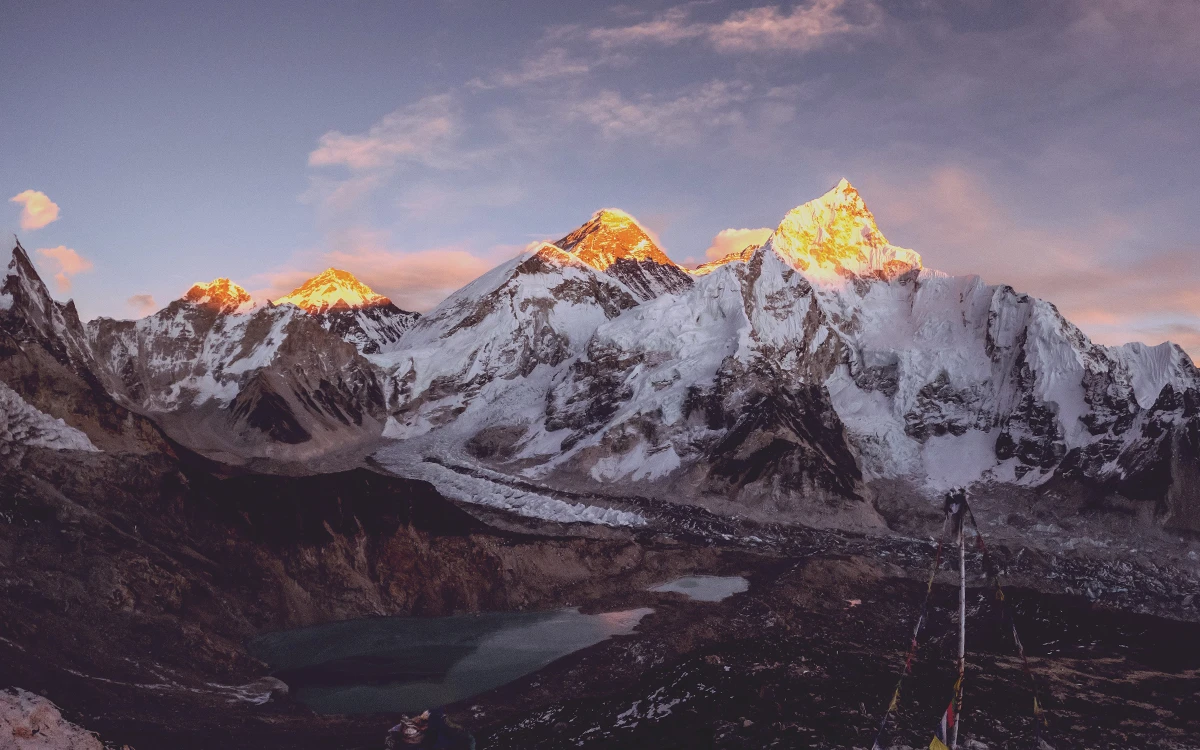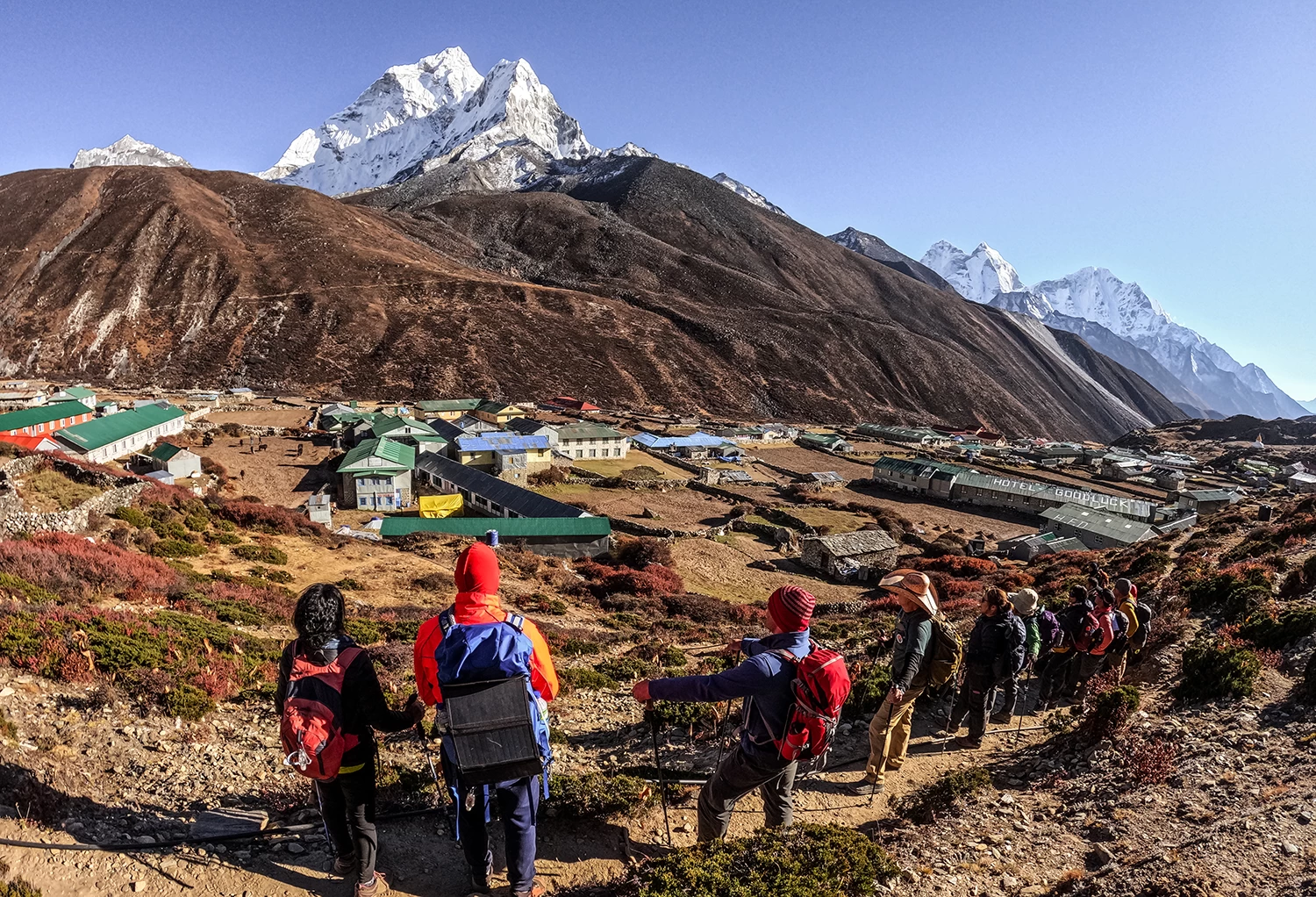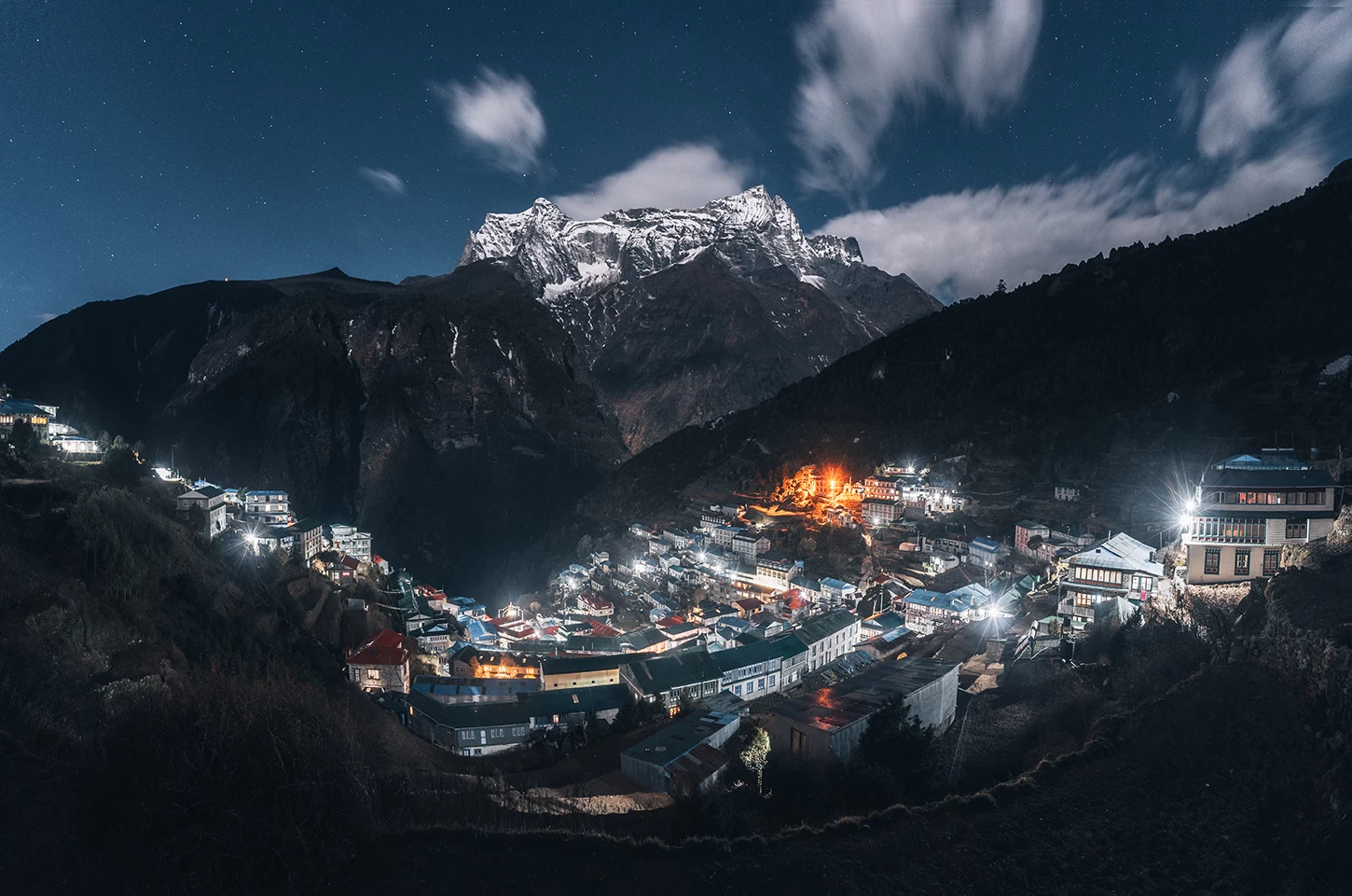

Ever dreamt of standing at the foot of the world's tallest peak, pampered in comfort? Our Luxury Everest Base Camp Trek makes it a reality! This 13-day journey blends the thrill of trekking with top-notch accommodations and breathtaking helicopter flights.
Start your adventure in style: Stay at the Kathmandu Marriott Hotel, a luxurious oasis amidst vibrant Kathmandu. Then, embark on your scenic trek, staying in cosy, premium lodges with private bathrooms and stunning mountain views.
Conquer Everest Base Camp, your way: We prioritize your comfort and safety with a well-paced itinerary, experienced guides, and a higher staff ratio. Two rest days ensure proper acclimatization and a supplementary oxygen system and medical kit provide peace of mind.
End your journey with a grand finale: After reaching Everest Base Camp, soar back to Kathmandu in a helicopter. Witness the majestic Himalayas from above, a breathtaking reward for your accomplishment.
Dreaming of Everest Base Camp, but with a touch of five-star pampering? Our Luxury Everest Base Camp Trek with Helicopter Return isn't just different, it's a complete redefinition of the Himalayan experience. Here's why it stands out:
This isn't your average trek, but if you're dreaming of reaching Everest Base Camp and soaking in the awe-inspiring Himalayan beauty, the Luxury Everest Base Camp Trek might be your perfect match!
The best time to trek to Luxury Everest Base Camp Trek is during the spring (March-May) or autumn (September-November) seasons. These periods offer stable weather, clear skies, and minimal rainfall, providing optimal conditions for trekking. However, remember that these are peak seasons, so expect more crowds and higher prices.
|
|
|
|---|
Your Everest Base Camp journey begins in Kathmandu, nestled among towering peaks. If you catch a clear day on your flight, prepare to be awestruck! Snow-capped giants stretch as far as you can see, promising a chain of unforgettable memories.
As soon as you land, our friendly team will greet you at the airport and whisk you away to your comfortable hotel. No need to navigate visas or luggage – we'll handle it all.
After a refreshing welcome drink and settling in, your expert trek leader will meet you in the hotel lobby to give you a detailed briefing about your upcoming adventure. That evening, we'll gather for a delicious group dinner at a typical Nepalese restaurant, savoring the local flavors and getting to know your fellow adventurers.
And finally, it's time to rest for the night in your hotel, surrounded by the unique charm of Kathmandu – the city of temples and, possibly, the most cows in the world!
Morning: Rest your jetlag legs and soak up the Kathmandu vibes! We'll visit two must-see spots: the giant Bouddhanath Stupa and the sacred Pashupatinath Temple.
Afternoon: Get prepped for the trek! Meet your leader for a briefing at the hotel, where they'll cover everything you need to know (think routes, weather, and what to pack).
Rest & Recharge: After the briefing, it's free time! Explore, shop for souvenirs, or just relax and get excited for your big adventure.
Farewell Feast: Enjoy a delicious early dinner tonight, as we need to catch a flight to Lukla super early tomorrow!
Get ready for a taste of Himalayan magic! Early in the morning, we'll hop on a short flight (about 35 minutes) from Kathmandu to Lukla, a tiny airstrip built by legends like Sir Edmund Hillary. Be prepared for jaw-dropping views of towering peaks - this is just a glimpse of what awaits!
Once we touch down in Lukla, we'll meet our crew and begin our trek up the Dudh Koshi Valley. The trail is well-marked, and even though today's hike isn't long, we'll gain some serious altitude (almost 4,100 feet!). But don't worry, we'll take it slow and steady, and by nightfall, we'll be cozy in our accommodation in Phakding.
Heads up! During peak season, flights to Lukla might operate from Ramechap Airport, a bit further away. This means an early wake-up call (around 2 am) and a 4-hour drive to catch a shorter flight (only 12 minutes!) to Lukla. We'll keep you updated if your trip is affected by this change.
Today, we continue our journey alongside the Dudhkoshi River, following a path through a cool pine forest. We'll cross several suspension bridges along the way, feeling the wind in our hair as we admire the views. We'll pass through tiny villages like Zapute, Toktok, Benkar, and Chumoa before reaching Monjo.
Here, we enter the Sagarmatha National Park, dedicated to protecting this beautiful mountain environment. After leaving the park, we'll cross another bridge and head towards the impressive Hillary Bridge, nestled at the foot of a hill. Once across, we'll climb uphill to our destination for the day: Namche Bazar.
From here, we might get a glimpse of Thamserku Mountain, and on a clear day, maybe even catch our first peek at the mighty Everest, Lhotse, Nuptse, and Kusum Khangru! Tonight, we'll sleep around 850 meters (2,788 feet) higher than our previous campsite – not bad for a day's work!
Today, we take a break at Namche Bazar, a bustling village nestled in a protected valley. This "rest day" is actually about helping your body adjust to the higher altitude, giving you a boost for the rest of the trek.
While your body gets used to the thin air, you have choices for some fun ways to spend the day! Here are a few ideas:
Hike to Everest View Hotel: Climb up for breathtaking views of, you guessed it, Everest!
Visit Khumjung and Khunde: Explore charming Sherpa villages with traditional stone houses and stunning scenery.
Walk to Thame: Stroll along the Bhote Khola River and breathe in the fresh mountain air.
Discover the National Park: Learn about Sherpa culture and see exhibits on the park's plants and animals.
No matter what you choose, your guides will be there to help and recommend the best option for you. So relax, explore, and soak in the magic of Namche Bazar!
Today, we walk alongside the glistening Dudh Koshi River, its glacial waters shimmering in the sun. As we follow the trail, we're treated to a stunning panorama of mountains: Everest, Nuptse, Lhotse, Thamserku, and even the beautiful Ama Dablam.
The air smells sweet with the scent of blooming rhododendrons, painting the path with vibrant colors. Keep your eyes peeled for glimpses of playful musk deer and colorful pheasants hiding in the trees.
At Sanasa, the trail splits. One path leads to the Gokyo Valley, while the other takes us towards our goal: Everest Base Camp. But today, we'll tackle a slightly steeper climb to Tengboche Monastery, the largest in the Khumbu region.
The effort is rewarded with even more incredible mountain views, seemingly reaching out to touch us. After spending a moment reflecting in the peaceful monastery, we'll continue through a magical forest of birch and rhododendron to our overnight stop in Deboche.
Tonight, we'll rest our legs after climbing about 270 meters (886 feet) higher than yesterday, all while soaking in the memories of an amazing day in the Himalayas.
Today's hike takes us past fascinating chortens (stone monuments) and colorful mani walls, whispering prayers with each passing step. We'll wind our way through small villages, soaking in the local life.
As we climb, our appetites will likely grow! Thankfully, a lunch break awaits with a delicious spread. And while we refuel, get ready to be blown away – you'll have jaw-dropping views of the mighty Ama Dablam looming right above you.
After lunch, we'll trek through Pangboche, the highest permanent settlement in this valley. Finally, we tackle the day's steepest climb to Dingboche, our cozy overnight stop.
Here in Dingboche, agriculture reigns supreme. You'll see neat fields, bordered by stone walls, where locals grow buckwheat, potatoes, and barley. This hard work fuels the community and adds a touch of charm to the landscape.
Tonight, we'll sleep about 692 meters (2,279 feet) higher than yesterday, feeling proud of our progress and energized for the next leg of our adventure.
Today is your acclimatization day in Dingboche. You have the opportunity to climb Nangkartshang Peak (16,730 ft/5,100 m) and enjoy breathtaking views of Makalu, Lhotse, Chalotse, Tawoche, and Ama Dablam. If you are acclimatizing well to the altitude, you can attempt the tough and steep climb to the top, which takes around 3 hours and 30 minutes. Alternatively, you can climb halfway up if you are feeling less energetic. Despite the challenging climb, the incredible views make it all worthwhile. After your descent, you will return to Dingboche for a late lunch and have the rest of the afternoon to relax and acclimatize.
The trail climbs steeply out of Dingboche, past a chorten, and ascends the valley gradually to Thukla at the end of the terminal moraine of the Khumbu Glacier. We stop here for a tea break and snack before the steep climb to Thukla Pass, a beautiful and poignant place with a line of memorials to climbers who have died on Everest. From Thukla Pass, we can enjoy a beautiful panorama of the peaks on the Nepal-Tibet border. The trail then eases off as we follow the valley to Lobuje, a tiny hamlet with a few teahouses. In the late afternoon, there is the option to walk up onto the lateral moraine of the Khumbu Glacier. The sunset on Nuptse is not to be missed.
Get ready for the highlight of your Everest Comfort trek today! We'll be setting foot on the Khumbu Glacier and reaching Gorakshep, the last village before Everest Base Camp!
Leaving Labuche, the trail starts flat, with one uphill section that takes about 40 minutes. Then, prepare to be amazed by the incredible Khumbu Glacier. See how climate change is shaping the Himalayas, and understand the delicate balance of nature here.
The hike to Gorakshep takes about 4 hours. Once you arrive, enjoy lunch, settle into your room, and rest for an hour. Then, conquer the challenging but rewarding climb to Kalapatthar for a sunset you'll never forget!
Picture this: the golden hues of sunset paint the mountains in a magical light, leaving you speechless. It's truly an unforgettable experience! After soaking in the view, head back down to Gorakshep before darkness, remembering to use your headlight.
Today's the culmination of your journey! Fuel up with breakfast, then prepare to witness the crown jewel of the Himalayas: Everest Base Camp.
Here, you'll stand at the feet of the mightiest mountain on Earth. Soak in the surreal atmosphere, surrounded by ice giants and glaciers glistening under the sun. This is a moment you'll treasure forever.
Feel the awe-inspiring power of nature as you touch the edge of the Khumbu Icefall, a treacherous labyrinth of ice and crevasses. Imagine Edmund Hillary and Tenzing Norgay, the first humans to conquer Everest, setting off from this very spot in 1953. Close your eyes and let their courage and determination inspire you.
But the magic doesn't end there. Capture breathtaking photos amidst the towering peaks, savor the victory of reaching Base Camp, and internalize the raw beauty of this incredible place.
Remember, even at Base Camp, safety is paramount. Follow your guide's instructions, listen to your body, and stay hydrated.
After this, we make our way back to Gorekshep and board a helicopter flight back to Kathmandu
Free and easy day to spend, perhaps doing shopping or rest at hotel’s beautiful court-yard. Please do not hesitate to let us know if you would like to extend your stay. Kindly email us for more details on extensions.
Your trip leader will escort you to the airport as per your flight time today.
Thank you for joining us on this trek and it has been a pleasure getting to know you during this time. We hope this venture has enriched your experience with happy memories. Keep in touch and hope to hear from you soon. Bon voyage for a safe and pleasant trip home.


| Departure | Return | Duration | Price From |
|---|
Please complete the form to submit your application.
Step 1: Tell us about yourself.
Fill out the Booking Form with as much information as possible.
Step 2: Pay 30% of your deposit.
Once the deposit has been paid, you have secured your position.
Step 3: Get excited and start preparing. You will receive regular contact about your upcoming trip and how to prepare.
Luxury Mountain Lodge: The Everest Comfort Lodge Trek offers top-tier lodge accommodations featuring twin beds, comfortable mattresses, and blankets. Most rooms include charging ports and attached bathrooms, except in Lobuche and Gorakshep villages. Many lodges also have dining halls heated with yak dung and an on-site restaurant. For added warmth, we recommend bringing your own sleeping bag and liner. Meals are typically provided at the lodge where you stay. Rooms are usually shared with one other person, but you can request separate arrangements, with single rooms available for an additional fee.
Battery Charging: After Namche Bazaar, charging stations are typically located in the lodge's dining area, with fees ranging from USD 1-3 per hour, depending on the device. Charging power banks usually incur a higher fee. Many lodges rely on solar panels for power, which can be unreliable during bad weather. To ensure you have enough power for multiple charges, it's recommended to bring a portable battery charger with a capacity of 15,000-20,000mAh.
Cellular Network: Consider an international calling plan from your home provider for reliable service. If you prefer a Nepali SIM card, Nepal Telecom (NTC) generally offers better coverage in remote areas compared to Ncell, though reception may still be limited in some places. SIM cards cost $1-2 and can be purchased in Kathmandu. You'll need to provide a passport copy and a passport-sized photo for their records. A 10GB data pack, costing $5-10, should be sufficient for 1-2 weeks, depending on your data usage.
Wi-Fi: After Namche Bazaar, you can purchase Wi-Fi at teahouses each night for $5-10. They typically offer plans with unlimited access for 12 or 24 hours. However, internet speeds can be slow and unreliable in remote areas.
Hot Showers: After Namche Bazaar, hot showers (solar or gas) are available for a fee of $4-7 per shower. Above 4,000 meters, only bucket showers are provided.
Toilets: Until Dingboche, we provide rooms with attached toilets. However, in Lobuche and Gorakshep, only basic mountain lodges are available, so you'll need to use shared toilets. These are typically common facilities, with both Western and squat-style options. Attached toilets are rare at higher elevations, and running water may not be available. Be sure to bring your toilet paper and soap.
Mountain Flights: Mountain flights operate exclusively in the mornings, offering a thrilling and picturesque experience. These flights use Twin Otter planes, which can accommodate approximately 18 passengers. Common carriers include Summit Air, Tara Air, and Sita Air.
Helicopter Flight: A helicopter flight is the best way to explore the Himalayas in luxury and in a short amount of time. A helicopter flight back is especially rewarding after the hard and challenging climb to Everest Base Camp. From Everest, the helicopter typically carries 2-5 people—only 2 from Gorakshep and up to 5 from Pheriche.
Vehicle: We provide reserved private vehicles for all your transportation needs, including pick-ups and drop-offs according to the itinerary. The type of vehicle-whether a car, jeep, or will be chosen based on the number of passengers and the terrain.
Food: Breakfast, lunch, and dinner are included in the price, except for desserts, giving you full flexibility to choose meals based on your appetite and preferences. The lodges offer a decent selection of food and drink options. For vegetarians, vegans, or those with dietary restrictions, please inform us at the time of booking so we can make appropriate arrangements.
Water: Carrying your own water bottle or hydration pack is mandatory. It’s recommended to have a bottle (1.5-2 litres) and a thermal flask (1 litre or smaller) during the trek. You can refill your bottle with boiled or bottled drinking water available at lunch spots and hotels. We strongly discourage buying plastic water bottles during the trek to minimize environmental impact.
Snacks: It's recommended to bring snacks like chocolates, dried fruits, and energy bars to enjoy during the trek.
Shops Along the Way: You'll encounter several well-stocked shops along the trails, especially in the lower elevations, where you can purchase water, snacks, and toiletries. There are also shops selling tea and beverages between lunch stops.
Our team consists of experienced and reliable tour leaders, guides, trek leaders, climbing leaders, and porters who are used to living in high altitudes.
We are committed to providing our clients with the best possible Himalayan experience. Our team is dedicated to your safety and enjoyment, and we will do everything we can to make your trek a success.
Additional Expenses: Beyond meals, potential expenses include drinks, laundry, tipping, and shopping. Please review the "Prices" section carefully to understand additional costs you may encounter during your trip.
Emergency Fund: While our trips are meticulously planned, unforeseen circumstances (like political unrest, strikes, bad weather, natural calamities, poor road conditions, airport closures, flight cancellations, etc.) can arise. For this reason, we recommend setting aside Rs. 25,000 as an emergency fund.
Currency: It's advisable to carry Nepali rupees for the trials, as most service providers transact in this currency.
ATMs and Credit Cards: Cash is the preferred payment method in most areas outside major cities. While some hotels and eateries in popular towns accept cards, reliability can be an issue. Card transactions may incur a 3-4% transaction fee. ATMs are limited in smaller towns, so carrying sufficient cash is recommended.
Tipping: Most hotels and eateries include a service charge with tips in their bills. You're encouraged to tip the trekking crew if you're satisfied with their service. A suggested guideline is USD 12-15 per day for guides and USD 7-10 per day for porters. Feel free to tip more if you're particularly pleased. Tips can be given in Nepali rupees or US dollars. Typically, the group pools money together to tip guides and porters on the final day of the trek during dinner.
Cancellations and Refunds: In case of flight delays or cancellations due to bad weather or unforeseen circumstances, we'll reschedule at no extra cost. However, any additional expenses incurred due to changes (including transportation, accommodation, and food) will be the trekker's responsibility.
Altitude Sickness: We take altitude sickness seriously and design our itineraries for a gradual ascent, covering shorter distances at higher elevations. To acclimatize, we stay an extra night at the same location or similar altitude after significant elevation gains.
During the trek, we prioritize hydration, avoid alcohol, and conduct acclimatization hikes as needed. Our guide will monitor your vitals with an oximeter daily to assess your body's response to altitude changes. If you experience AMS symptoms or headaches, please inform your guide immediately. Mild headaches can often be managed with food, hydration, and rest. While we generally don't recommend Diamox (altitude sickness pills), you may consider taking them as a precaution if you're coming from sea level.
Trail Safety: Our guide carries a well-equipped first-aid kit at all times. Please review our equipment and medical checklist for better preparedness, as common issues like foot blisters and knee pain can be addressed with proper packing. If you have pre-existing health conditions, please inform us upon booking.
Keep your passport, flight tickets, phone, wallet, camera equipment, cash, and valuables in your daypack or waist belt. Avoid bringing expensive items like jewellery or large amounts of cash for security reasons.
Insurance: Obtaining travel insurance that covers emergency evacuation (including helicopter rescue) and medical expenses up to 5,500 meters (18,044 feet) above sea level is mandatory.
Drinking Water: Water safety is paramount. To avoid waterborne diseases, we recommend drinking only boiled water or using steriPEN, LifeStraw, or purification tablets during the trek.
Immunization: Recommended immunizations before trekking in Nepal include Hepatitis A, Typhoid fever, and chickenpox. While not strictly enforced, they are for your safety.
Emergency Contacts: In case of issues or emergencies, please contact the lead guide or any team member. They can assist with contacting nearby hospitals, transportation, ambulances, police offices, army checkpoints, and embassies, and facilitate rescue operations. We'll provide a list of relevant emergency contacts before your trip.
Leave No Trace: Please avoid littering and dispose of all trash properly; you can hand it to your guide. Refrain from plucking flowers or vandalizing trails. Let's keep the trails as pristine as we found them.
Rules and Conduct: Physical violence, verbal abuse, harassment, solicitation, and the use or possession of illegal drugs or materials are strictly forbidden.
Alcohol and Drugs Policy: Excessive alcohol consumption can dehydrate you and affect your trekking safety. We advise limiting alcohol intake during the day and saving any drinks for the evening.
No Handouts: Do not give money or handouts to beggars or children, as it encourages a culture of begging.
Photography and Drones: Always ask for permission before photographing locals, though many are happy to be photographed. Note that drone usage is strictly regulated in Nepal, so please avoid flying drones.
Traveling in a Group: Group travel offers a mix of ages, fitness levels, and paces. Please respect the schedule set by your guide to ensure a smooth experience for everyone.
Passport: All foreign visitors to Nepal must possess a valid passport with a minimum of 6 months validity beyond their planned departure date.
Visa: Nepal visa can be obtained on arrival at Kathmandu airport (Tribhuvan International Airport) or you can obtain Nepal visa prior to your arrival through the Nepalese embassies, diplomatic missions and consulates near your location. Nepal Visa is also issued at the entry points if you are entering Nepal by land.
Visa Fees: Nepal visa fees are listed below as per the duration.
Multiple entry 15 days – US$ 30 or equivalent convertible currency
Multiple entry 30 days – US$ 50 or equivalent convertible currency
Multiple entry 90 days – US$ 125 or equivalent convertible currency
Important Note: It is always advisable to verify the visa requirements upon booking your trip. Visa requirements may vary depending on where you are from and it's also recommended to check the transit country requirements as well.
While we share this information in good faith, it is crucial for you to independently verify it and acknowledge that you bear full responsibility for your visa requirements.
What to Pack: Kathmandu offers many gear shops where you can purchase or rent essential items. If you forget anything, Thamel is a convenient place to buy it before your trek. You can rent items like a sleeping bag for around USD 2-3 per day.
What Not to Carry: At the airport, items such as oxygen cylinders, drones, satellite phones (without permission), and sharp objects like knives and scissors may be confiscated.
Check the Trekking Equipment Checklist here...

Hiking the Himalayas with Community Trek in 2022 was more than just a vacation; it was a life-changing adventure for my family and me. From the awe-inspiring views of Everest to the warm hospitality of the Sherpa people, every moment was truly unforgettable. Community Trek flawlessly organized everything, ensuring our comfort and safety every step of the way. Our guide, Ramesh, was not only knowledgeable and professional but also became a trusted friend, sharing local stories and traditions that enriched our experience. The porters were also incredible, always there to lend a helping hand with a smile. We're already planning our next adventure with Community Trek, and I wholeheartedly recommend them to anyone seeking an exceptional and unforgettable journey in the breathtaking Himalayas of Nepal!"
Write Your Review
Give Review